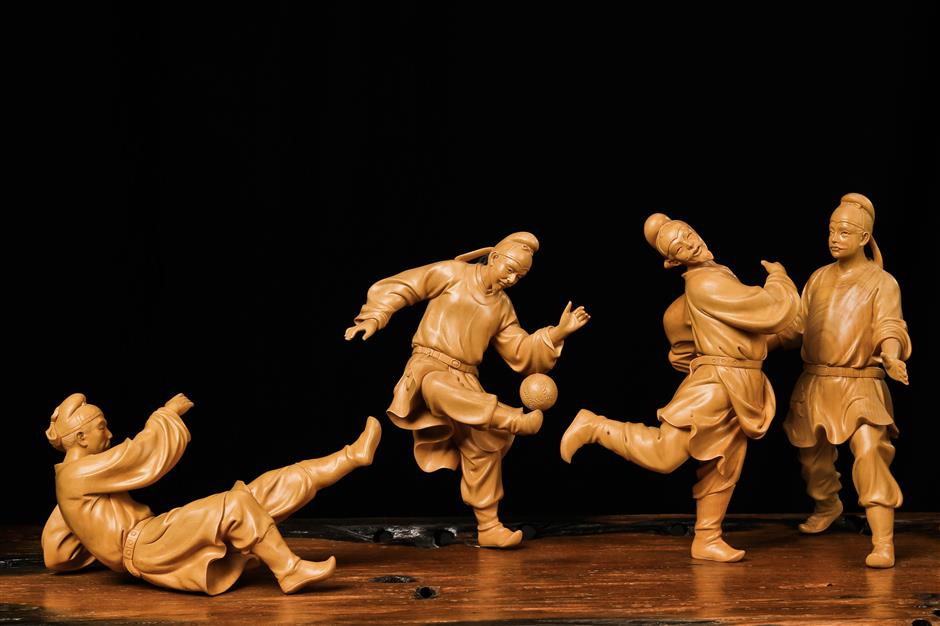Celebrating the ancient art of wood carving
Zhejiang Museum is hosting a series of exhibitions to promote the public’s awareness of protecting traditional craftsmanship.
Varied themes are highlighted at the exhibit, from lacquered wares and ceramics to silk products and bamboo- weaving handicrafts.
Visitors can linger over some terrifically detailed boxwood figurines engraved by the renowned sculpturer Wu Yaohui. He is the inheritor of the Yueqing-school boxwood carving craft, which is one of Zhejiang Province’s intangible cultural heritages.

A woodcarving work that depicts Tang Dynasty (AD 618-907) people playing an ancient Chinese football game called cuju.
The 55-year-old Wu has been sculpting for more than 27 years. He was apprenticed to master Ye Runzhou. Ye’s family was one of the pioneers of the boxwood sculpting craft and enjoyed prestige in this field.
In April, Wu was named as a “National Craft and Art Master” by virtue of his superb carving techniques and great contribution to boxwood sculpting.
His works carry on the style of the Yueqing school, which is one of the three famous sculpting schools in Zhejiang Province, along with Dongyang wood sculpture and Qingtian stone sculpture.
Vivid figures and a glossy finish characterize his boxwood sculptures. Traditionally, Buddhist characters and immortals were major subjects of this art. However, Wu picks ordinary life scenarios, elegant women, animals and flowers as themes.

A artwork depicts Tang Dynasty people playing cuju.
The highlight of the exhibition is the work that depicts Tang Dynasty (AD 618-907) people playing an ancient Chinese football game called cuju (蹴踘). The smooth lines and dynamic bodies vividly reflect players’ vibrancy and energy. It is the earliest form of football recognized by the FIFA.
Wu is a Yueqing native. The county is located in the southeast of the province and boasts ample boxwood trees, which is a tough type of wood that features a fine and smooth texture, superior to other wood.
As a slow-growing shrub and small tree, typically 1 to 6 meters tall, a 50-year-old boxwood is only 15 centimeters in diameter. Though they are widely distributed in Zhejiang, only trees older than 50 years old are suitable for sculptures.
The scarcity of carving materials makes boxwood carving precious. Its value approaches that of other precious materials and stones for carving. Boxwood sculptures darken over time, giving them a cherished patina and quaint tone.
A single boxwood sculpture takes months to finish. It goes through several stages of molding, cutting, carving, polishing and lacquering before it is completed. That makes boxwood sculptures more valuable than other wooden sculpting varieties.
People traditionally put boxwood sculptures in their homes to bring good luck and blessings. Now, more people understand the artistic value of boxwood sculptures, progressing aesthetics and exquisite designs are now popular with artistic work hunters.
Date: Through August 19, closed on Mondays
Venue: Wulin Pavilion of Zhejiang Museum
Address: Zone E, West Lake Cultural Square, 581 Zhongshan Rd N.
Admission: Free

Wu Yaohui is good at carving elegant women with smooth lines.
















